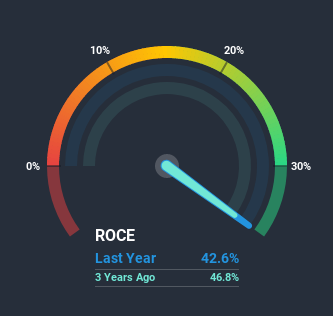Are Investors Overlooking Returns On Capital At Home Depot (NYSE:HD)?

Did you know there are some financial metrics that can provide clues of a potential multi-bagger? Ideally, a business will show two trends; firstly a growing return on capital employed (ROCE) and secondly, an increasing amount of capital employed. If you see this, it typically means it's a company with a great business model and plenty of profitable reinvestment opportunities. With that in mind, the ROCE of Home Depot (NYSE:HD) looks attractive right now, so lets see what the trend of returns can tell us.
Return On Capital Employed (ROCE): What is it?
For those who don't know, ROCE is a measure of a company's yearly pre-tax profit (its return), relative to the capital employed in the business. The formula for this calculation on Home Depot is:
Return on Capital Employed = Earnings Before Interest and Tax (EBIT) ÷ (Total Assets - Current Liabilities)
0.43 = US$17b ÷ (US$63b - US$24b) (Based on the trailing twelve months to August 2020).
Therefore, Home Depot has an ROCE of 43%. That's a fantastic return and not only that, it outpaces the average of 9.7% earned by companies in a similar industry.
See our latest analysis for Home Depot
In the above chart we have measured Home Depot's prior ROCE against its prior performance, but the future is arguably more important. If you'd like to see what analysts are forecasting going forward, you should check out our free report for Home Depot.
What Does the ROCE Trend For Home Depot Tell Us?
We'd be pretty happy with returns on capital like Home Depot. Over the past five years, ROCE has remained relatively flat at around 43% and the business has deployed 43% more capital into its operations. With returns that high, it's great that the business can continually reinvest its money at such appealing rates of return. If these trends can continue, it wouldn't surprise us if the company became a multi-bagger.
What We Can Learn From Home Depot's ROCE
In summary, we're delighted to see that Home Depot has been compounding returns by reinvesting at consistently high rates of return, as these are common traits of a multi-bagger. On top of that, the stock has rewarded shareholders with a remarkable 158% return to those who've held over the last five years. So while the positive underlying trends may be accounted for by investors, we still think this stock is worth looking into further.
Like most companies, Home Depot does come with some risks, and we've found 2 warning signs that you should be aware of.
Home Depot is not the only stock earning high returns. If you'd like to see more, check out our free list of companies earning high returns on equity with solid fundamentals.
This article by Simply Wall St is general in nature. It does not constitute a recommendation to buy or sell any stock, and does not take account of your objectives, or your financial situation. We aim to bring you long-term focused analysis driven by fundamental data. Note that our analysis may not factor in the latest price-sensitive company announcements or qualitative material. Simply Wall St has no position in any stocks mentioned.
Have feedback on this article? Concerned about the content? Get in touch with us directly. Alternatively, email editorial-team@simplywallst.com.

 Yahoo News
Yahoo News 

